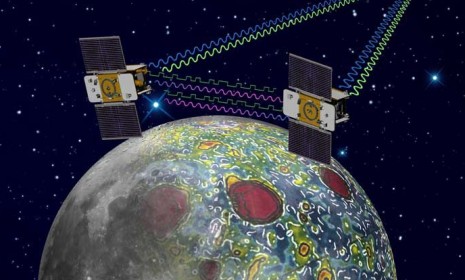Mapping the inside of the moon
NASA's latest lunar exploration will give us a never-before-seen glimpse of the moon below the surface

Though the moon is our closest neighbor in space, there's much we don't know about it. For instance: Did a second moon once crash into our moon, destroying the second moon and leaving our moon pockmarked with craters? NASA hopes to shed light on this and other questions as it sends a lunar probe named GRAIL (Gravity Recovery and Interior Laboratory) to orbit the moon. Here, a brief guide to this mission:
What will GRAIL do?
GRAIL, which launched Saturday, will split into two separate satellites, GRAIL-A and GRAIL-B. When the pair of solar-powered craft reach the moon in December, they'll orbit it 12 times a day for about three months. The main purpose of the mission is to create a digital map of the inside of the moon by analyzing the moon's gravitational field.
The Week
Escape your echo chamber. Get the facts behind the news, plus analysis from multiple perspectives.

Sign up for The Week's Free Newsletters
From our morning news briefing to a weekly Good News Newsletter, get the best of The Week delivered directly to your inbox.
From our morning news briefing to a weekly Good News Newsletter, get the best of The Week delivered directly to your inbox.
How will these lunar probes measure gravity?
Through "precision formation flying." As the two tightly coordinated GRAIL craft move above the moon, they'll slow down or speed up based on how strong or weak the moon's gravitational force is at different points across its surface. "By continually taking very precise measurements of the distance between the two spacecraft, the mission can measure changes in the gravitational field of the moon," says Brian McLaughlin at Wired.
So, studying gravity explains the interior of the moon?
Yes. It's the varying density of the crust, mantle, and other geological features of the moon's interior that determine gravitational changes, says Scott Gold in the Los Angeles Times. So mapping the moon's gravity "will allow for the first comprehensive assessment of the moon's crust, mantle, and core." This gravitational data will be used to produce a "map" of the moon's interior, so scientists can better understand how the moon was formed, why lava fields are found on one side of the moon but not the other, and perhaps even how rocky planets like Earth were created.
A free daily email with the biggest news stories of the day – and the best features from TheWeek.com
Sources: C-S Monitor, LA Times, Wired
-
 Inside a Black community’s fight against Elon Musk’s supercomputer
Inside a Black community’s fight against Elon Musk’s supercomputerUnder the radar Pollution from Colossal looms over a small Southern town, potentially exacerbating health concerns
-
 Codeword: December 4, 2025
Codeword: December 4, 2025The daily codeword puzzle from The Week
-
 Sudoku hard: December 4, 2025
Sudoku hard: December 4, 2025The daily hard sudoku puzzle from The Week